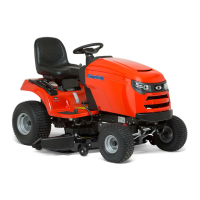Landlord / 1700 / 2700 Series
TP 300-2226-02-LL-SMA
1/20018
Check Fluid Levels continued…
Engine Coolant (Kawasaki Models)
The engine coolant level and quality should be checked
before each use, when the engine is off and cool.
1. Check coolant in the overflow reservoir (C, Figure
12). Coolant should be green in color and coolant
level should be between the “H” and “L” marks on the
tank.
2. If the coolant level is below the “L” mark on the over-
flow reservoir, then with the engine off and cool,
remove the radiator cap (D, Figure 12). Add coolant
(50/50 mixture of ethylene glycol antifreeze and dis-
tilled water), slowly fill the radiator to the bottom of
the radiator cap filler neck.
3. Inspect for leaks in system as described on the next
section. Run the engine until it reaches normal oper-
ating temperature and recheck the coolant reservoir
level.
Inspect Cooling System
(Kawasaki Models)
Inspect the radiator and the hoses.
1. Inspect radiator inlet and outlet tubes for cracks,
kinks, dents, and fractured seams. Have radiator
repaired or replaced if necessary.
2. Check for dirt and insects that may be lodged in the
radiator. Clean them out using compressed air or a
low-pressure washer.
Figure 12. Engine Compartment (View from Right)
A. Rubber Strap D. Radiator Cap
B. Oil Filter E. Oil Fill/Dipstick
C. Overflow Reservoir
A
B
C
E
D
Figure 13. Checking Tire Pressure
Tire Pressure
Front 12-15 psi (83-104 kPa)
Rear 6-8 psi (41-55 kPa)
WARNING
Engine coolant contains ethylene glycol and is
harmful or fatal if swallowed. Avoid contact with
eyes, skin, and clothing. Store in tightly closed
containers. Wash thoroughly after handling. Follow
safety guidelines on coolant container labels.
Reduce & Check Tire
Pressures
The tires are over-inflated for shipping purposes. Inflate
to the pressures shown. Note that these pressures may
differ slightly from the “Max Inflation” stamped on the
side-wall of the tires. The pressures shown provide prop-
er traction, improve cut quality, and extend tire life.

